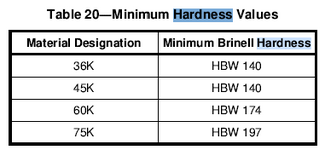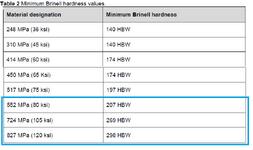WendelTrento
Materials
- Jul 23, 2020
- 13
Dear all,
Good afternoon,
The API 6A standard specifies the minimum hardness values for carbon steels with a yield strength of 36K to 75K.

I have a hardness standard from a client that informs the minimum value for steels with a yield strength above the API.
Hardness standard text:
The minimum Brinell hardness values from ISO 10423 or API 6A [1], ISO 13628-4 [3] and API 17D [4] are given in Table 2.

Could you, if possible, inform me from which literature my client obtained these minimum hardness values for steels with a yield strength of 80ksi to 120ksi?
Att,
Wendel Trento
Good afternoon,
The API 6A standard specifies the minimum hardness values for carbon steels with a yield strength of 36K to 75K.

I have a hardness standard from a client that informs the minimum value for steels with a yield strength above the API.
Hardness standard text:
The minimum Brinell hardness values from ISO 10423 or API 6A [1], ISO 13628-4 [3] and API 17D [4] are given in Table 2.

Could you, if possible, inform me from which literature my client obtained these minimum hardness values for steels with a yield strength of 80ksi to 120ksi?
Att,
Wendel Trento
